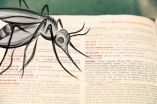(Press-News.org) Montreal, February 26, 2014 — New acquaintances are often judged by their handshake. Research has now recognized the simple squeeze as an important diagnostic tool in assessing strength and quality of life among critical care patients.
In a study published in the journal, Support Care Cancer, Concordia professor Robert Kilgour and his colleagues at the McGill Nutrition and Performance Laboratory confirmed a link between handgrip strength and survival rates.
The test was simple: 203 patients fighting advanced-stage cancers squeezed a device known as a dynamometer with their dominant hand. The instrument then measured peak grip strength.
Because it requires minimal equipment, this method of evaluation is both portable and practical, says Kilgour: "This measure is one of several to categorize patients according to the severity of their disease. It can help determine interventions they may need, whether clinical, nutritional or functional."
While other diagnostic tests rely on a patient's self-reporting or examine related factors such as decreased body weight,the handgrip test directly focuses on body strength.
Its precision allows doctors to better assess a patient's decline.
Clinicians typically classify patients by percentiles; those in the bottom 10th percentile are in the most serious condition, while those in the 25th are somewhat stronger. In most cases, slowing a patient's decline and maintaining a decent quality of life can be a significant accomplishment.
Kilgour and his colleagues believe the grip test may help all categories of patients, especially those in the 25th percentile. At this stage, even modest interventions, like starting exercise or a diet change, can yield results, boosting both the physical and mental health of patients.
INFORMATION:
Partners in research: This work was supported in part by the Canadian Foundation for Innovation and the Canadian Institutes of Health Research.
Related links:
Department of Exercise Science
Robert Kilgour
McGill Nutrition and Performance Laboratory
Canada Foundation for Innovation
Canadian Institutes of Health Research
Media contact:
Cléa Desjardins
Senior advisor, media relations
University Communications Services
Concordia University
Phone: 514-848-2424, ext. 5068
Email: clea.desjardins@concordia.ca
Web: concordia.ca/now/media-relations
Twitter: twitter.com/CleaDesjardins
Can a simple handshake predict cancer survival rates?
New research shows that handgrip strength may be linked to a person's ability to fight disease
2014-02-26
ELSE PRESS RELEASES FROM THIS DATE:
Ambitious new pollution targets needed to protect Lake Erie from massive 'dead zone'
2014-02-26
ANN ARBOR—Reducing the size of the Lake Erie "dead zone" to acceptable levels will require cutting nutrient pollution nearly in half in coming decades, at a time when climate change is expected to make such reductions more difficult.
That's one of the main conclusions of a comprehensive new study that documents recent trends in Lake Erie's health. It offers science-based guidance to policymakers seeking to reduce the size of toxic algae blooms and oxygen-starved regions called hypoxic zones, or dead zones—two related water-quality problems that have seen a resurgence ...
UNC researchers team up to find new target for dengue virus vaccine
2014-02-26
CHAPEL HILL, NC – Creating a vaccine that protects people from all four types of dengue virus has frustrated scientists for decades. But researchers at the University of North Carolina have discovered a new target for human antibodies that could hold the key to a vaccine for the world's most widespread mosquito-borne disease.
Using an experimental technique new to the dengue field, the labs of Ralph Baric, PhD, and Aravinda de Silva, PhD, showed that a molecular hinge where two regions of a protein connect is where natural human antibodies attach to dengue 3 to disable ...
Research shows ovulation motivates women to outdo other women
2014-02-26
For approximately one week every month, millions of women change their economic behavior and become more focused on their social standing relative to other women. According to new research from The University of Texas at San Antonio (UTSA) and the University of Minnesota's Carlson School of Management, the ovulatory cycle alters women's behavior by subconsciously motivating them to outdo other women. This research could have important implications for marketers, consumers and researchers.
The researchers conducted three studies, one of which had ovulating and nonovulating ...
New advances in the chronic lymphocytic leukaemia genome
2014-02-26
This news release is available in Spanish. A study led by Dr. Roderic Guigó from the Centre for Genomic Regulation in Barcelona, as part of the Chronic Lymphatic Leukaemia Genome Consortium, has made new advances in the study of this disease. The work, which was published (in print version) last week in the journal Genome Research, scrutinised the functional profile of the genes and mutations associated with leukaemia.
The Spanish Chronic Lymphatic Leukaemia Genome Consortium had previously identified the principal mutations involved in the development of the disease. ...
Kessler Foundation researchers study factors affecting self-reporting among people with TBI
2014-02-26
West Orange, NJ. February 26, 2014. Kessler Foundation researchers have found that among individuals with TBI, depression and self-awareness affect subjective reports of memory, quality of life (QOL), and satisfaction with life. The study was published in the February 2014 issue of Brain Injury. (Yael Goverover, Nancy D. Chiaravalloti: The impact of self-awareness and depression on subjective reports of memory, quality- of-life and satisfaction with life following TBI. (doi:10.3109/02699052.2013.860474)
Impairment in self-awareness (the ability to accurately recognize ...
Nanoscale freezing leads to better imaging
2014-02-26
It's an odd twist. For scientists to determine if a cell is functioning properly, they must destroy it.
This is what happens in X-ray fluorescence microscopy when biological specimens are exposed to ionizing radiation, which provides images with a level of detail that conventional microscopes just can't match. This exposure can change what is being imaged in profound ways, possibly giving false accounts of how the cell actually works.
To address this issue, researchers at the U.S. Department of Energy's (DOE) Argonne National Laboratory created a new probe that freezes ...
Screen some patients with acute pancreatitis for pancreatic cancer, SLU researchers suggest
2014-02-26
ST. LOUIS – In a study published in Clinical Gastroenterology and Hepatology, Saint Louis University researchers have found a link between acute pancreatitis (inflammation of the pancreas) and pancreatic cancer, a finding which may eventually lead to some pancreatic cancers being detected earlier.
Principle investigator Banke Agarwal, M.D., associate professor of gastroenterology and hepatology at Saint Louis University, says the study builds on earlier research suggesting a connection between the two illnesses.
"Our study demonstrates that there is a much higher ...
Photopharmacology: Optoswitches turn pain off and sight on
2014-02-26
Photoreactive compounds developed by scientists of Ludwig-Maximilians-Universitaet (LMU) in Munich directly modulate nerve-cell function, and open new routes to the treatment of neurological diseases, including chronic pain and certain types of visual impairment.
All modes of sensory perception are based on communication between nerve cells. Both the response to the primary stimulus and the transmission of the resulting signal depend on the function of specialized receptor proteins that are associated with the surface membranes of neurons. Many sensory neurons respond ...
Researchers trap moths with plant-produced sex pheromone
2014-02-26
MANHATTAN, Kan. — A collaborative experiment involving a Kansas State University biochemist may mark the beginning of an effective, environmentally friendly plant-based method of insect control.
Timothy Durrett, assistant professor of biochemistry and molecular biophysics, was part of the collaboration that used various plant and moth enzymes to engineer plants that emitted sex pheromones that mimic those naturally produced by two species of moths.
The research recently appeared in the journal Nature Communications, "A plant factory for moth pheromone production." The ...
Uninsured parents don't take breastfeeding classes, even though breast is best
2014-02-26
ANN ARBOR, Mich. – Just 12 percent of parents without insurance coverage take breastfeeding support classes that can offer crucial support and encourage new moms to breastfeed, according to a new University of Michigan C.S. Mott Children's Hospital National Poll on Children's Health.
The American Academy of Pediatrics recommends exclusively breastfeeding until babies are 6 months of age followed by breastfeeding in combination with the introduction of complementary foods until at least 12 months of age. However, only about half of moms in the US are still breastfeeding ...
LAST 30 PRESS RELEASES:
Concurrent frailty + depression likely boost dementia risk in older people
Living in substandard housing linked to kids’ missed schooling and poor grades
Little awareness of medical + psychological complexities of steroid cream withdrawal
Eight in 10 trusts caring for emergency department patients in corridors, finds BMJ investigation
NASA’s Webb telescope finds bizarre atmosphere on a lemon-shaped exoplanet
The gut bacteria that put the brakes on weight gain in mice
Exploring how patients feel about AI transcription
Category ‘6’ tropical cyclone hot spots are growing
Video: Drivers struggle to multitask when using dashboard touch screens, study finds
SLU research shows surge in alcohol-related liver disease driving ‘deaths of despair’
Rising heat reshapes how microbes break down microplastics, new review finds
Roots reveal a hidden carbon pathway in maize plants
Membrane magic: FAMU-FSU researchers repurpose fuel cells membranes for new applications
UN Member States pledge to increase access to diagnosis and inhaled medicines for the 480 million people living with COPD
Combination therapy shows potential to treat pediatric brain cancer ATRT
Study links seabird nesting to shark turf wars in Hawai‘i
Legal sports betting linked to sharp increases in violent crime, study finds
Breakthrough AI from NYUAD speeds up discovery of life-supporting microbes
New Eva Mayr-Stihl Foundation funding initiative boosts research at University of Freiburg on adaptation of forests to global change
The perfect plastic? Plant-based, fully saltwater degradable, zero microplastics
Bias in data may be blocking AI’s potential to combat antibiotic resistance
Article-level metrics would provide more recognition to most researchers than journal-level metrics
Satiety’s little helper: Protein that supports appetite regulating protein identified
UF dives deep into predicting storm damage with computer models
A stormy ocean voyage yields insights on the global carbon cycle
Scientists identify first non-coding gene that controls cell size
Demonstration of altermagnetism in RuO₂ thin films -- A new magnetic material for the AI era
Penn researchers awarded $25M to conduct trial using smartphones to fight heart disease
PCORI awards funding for new patient-centered healthcare research
Exploring the origins of the universe: 145 low-noise amplifiers complete ALMA telescopes
[Press-News.org] Can a simple handshake predict cancer survival rates?New research shows that handgrip strength may be linked to a person's ability to fight disease





